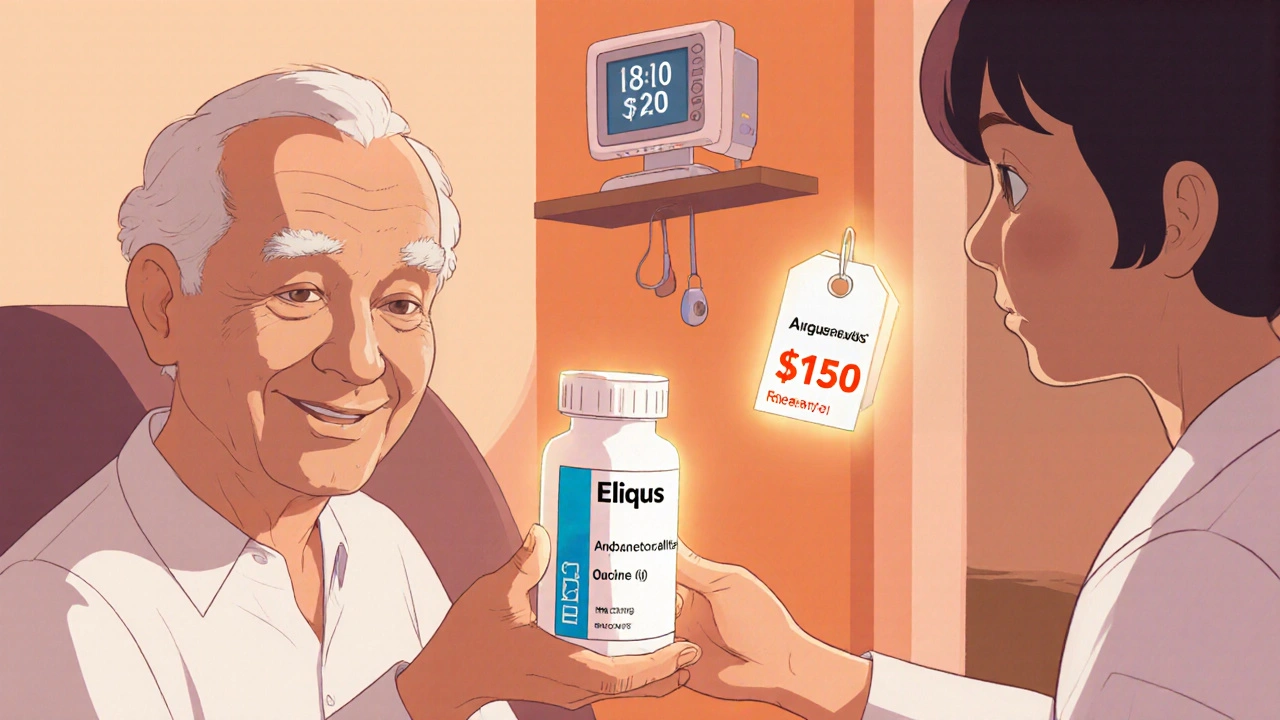Renal Function Anticoagulant Safety Calculator
Check Your Kidney Function Safety
Enter your creatinine clearance (CrCl) in mL/min to see which anticoagulants are safe for your kidney function
Your Safety Results
| Eliquis (Apixaban) | Safe |
| Rivaroxaban | |
| Dabigatran | |
| Warfarin | Safe |
When doctors talk about blood thinners, Eliquis (Apixaban) is a direct oral anticoagulant that blocks Factor Xa, reducing the risk of clots in the heart and veins. But the market is crowded: rivaroxaban, dabigatran, and the decades‑old warfarin all vie for a spot in treatment plans. This guide breaks down how Eliquis stacks up against those alternatives in 2025, so you can see which drug fits your health goals, kidney function, and budget.
Why a Comparison Matters
Choosing a blood thinner isn’t just about “which pill looks easier”. Each option has a unique profile for dosing, monitoring, food interactions, and side‑effect risk. A clear side‑by‑side view helps patients, caregivers, and clinicians avoid costly trial‑and‑error. Below you’ll find the key decision points that matter most in daily practice.
Core Decision Criteria
- Indication coverage - Does the drug handle atrial fibrillation, deep‑vein thrombosis (DVT), or pulmonary embolism?
- Dosing convenience - Once‑daily vs twice‑daily regimens.
- Renal handling - How the drug behaves when kidneys aren’t at full strength.
- Monitoring needs - Lab work required after the first prescription.
- Food and drug interactions - Grapefruit, antibiotics, or over‑the‑counter meds that can tip the balance.
- Cost and insurance coverage - Out‑of‑pocket price in 2025.
Quick Reference Comparison Table
| Attribute | Eliquis (Apixaban) | Rivaroxaban | Dabigatran | Warfarin |
|---|---|---|---|---|
| Mechanism | Factor Xa inhibitor | Factor Xa inhibitor | Direct thrombin inhibitor | Vitamin K antagonist |
| Typical Dose | 5 mg BID | 20 mg QD (10 mg if CrCl < 50 mL/min) | 150 mg BID (110 mg BID if >80 y) | 2‑10 mg QD, titrated to INR 2‑3 |
| Renal Clearance | 27 % (safe down to CrCl 15 mL/min) | 33 % (dose cut‑off at CrCl 15 mL/min) | 80 % (avoid if CrCl < 30 mL/min) | Minimal, but requires frequent INR checks |
| Monitoring | None under stable conditions | None under stable conditions | None under stable conditions | INR 2‑3, weekly to monthly |
| Food Interactions | None | High‑fat meals can reduce absorption | Avoid grapefruit | Vitamin K‑rich foods affect INR |
| Cost (2025 avg U.S.) | $15‑$20 per month (generic Apixaban) | $12‑$18 per month | $20‑$25 per month | $4‑$8 per month (generic) |
Deep Dive: How Each Drug Works
Rivaroxaban is another Factor Xa inhibitor that, like Eliquis, blocks the final step in clot formation. The main practical difference is that rivaroxaban is taken once a day, which some patients prefer. However, its absorption drops if you eat a fatty meal right before the pill.
Dabigatran is a direct thrombin inhibitor that stops the conversion of fibrinogen to fibrin. Because it relies heavily on the kidneys, doctors avoid it in moderate‑to‑severe renal impairment.
Warfarin is a vitamin K antagonist that has been the standard of care for more than 60 years. It works well for many indications but demands regular INR monitoring and strict diet control.
Kidney Function: Who Should Avoid Which Drug?
Renal health shapes every anticoagulant choice. For patients with chronic kidney disease (CKD) stage 3 (eGFR 30‑59 mL/min), Eliquis remains safe because only a quarter of the dose is cleared renally. Rivaroxaban can be used down to an eGFR of 15 mL/min if the dose is reduced, but clinicians must watch for accumulation.
Dabigatran, with roughly 80 % renal clearance, is usually off‑limits once eGFR falls below 30 mL/min. Warfarin’s metabolism bypasses the kidneys, making it the fallback for severe renal impairment, yet the trade‑off is intensive INR monitoring.
Bleeding Risk and Reversal Options
All anticoagulants raise bleeding risk, but the ability to reverse the effect differs. A specific antidote, Andexanet alfa, can quickly neutralize both Eliquis and rivaroxaban in emergency surgery or life‑threatening bleed.
Dabigatran’s reversal is handled by Idarucizumab, a monoclonal antibody that binds dabigatran almost instantly.
Warfarin is reversible with vitamin K, fresh‑frozen plasma, or prothrombin complex concentrate (PCC), but the process is slower compared with the newer agents.

Real‑World Cost Considerations
Insurance formularies in 2025 often place Eliquis, rivaroxaban, and dabigatran on a Tier 2 or Tier 3, meaning a modest co‑pay. However, many plans now list generic apixaban (the molecule behind Eliquis) as a Tier 1 option, shaving the price to under $20 a month. Warfarin stays the cheapest, but remember the hidden cost of frequent lab visits.
Putting It All Together: When to Choose Eliquis
Look for these clues:
- Patients with non‑valvular atrial fibrillation who need a twice‑daily regimen that fits their lifestyle.
- Those with moderate renal impairment (eGFR 15‑30 mL/min) who still want a DOAC without weekly blood draws.
- Individuals who dislike dietary restrictions-Eliquis has no food interactions.
- Situations where rapid reversal (andexanet alfa) is a safety net.
If any of the above don’t apply, rivaroxaban’s once‑daily dose, dabigatran’s stronger effect on clot‑breaking, or warfarin’s low price might be better choices.
Bottom Line Checklist
- Confirm the primary indication (AFib, DVT/PE, prophylaxis).
- Check renal function (eGFR) before picking a DOAC.
- Ask about insurance coverage for generic apixaban vs brand‑name Eliquis.
- Consider reversal agents available at your hospital.
- Review patient preference for dosing frequency.
Can I switch from warfarin to Eliquis?
Yes. Most clinicians overlap the two drugs for 1‑2 days while checking INR. After INR stays below 2.0, warfarin can be stopped and Eliquis started at the standard dose.
Is Eliquis safe for patients over 80 years old?
For most seniors, the standard 5 mg BID dose works, but if they weigh under 60 kg or have eGFR 15‑30 mL/min, the dose should be reduced to 2.5 mg BID.
What happens if I miss a dose of Eliquis?
Take the missed tablet as soon as you remember, unless it’s almost time for the next dose. Then skip the missed one and continue with your regular schedule. Never double‑dose.
Do I need regular blood tests while on Eliquis?
Routine labs aren’t required for stable patients. Your doctor may order a CBC or renal panel yearly, but no INR checks are needed.
How does Eliquis compare cost‑wise to generic warfarin?
Warfarin itself is cheaper, but you’ll pay for INR monitoring visits. Generic apixaban now averages $15‑$20 per month, and many insurers cover it fully, making the total cost comparable for many patients.
Can Eliquis be taken with aspirin?
Only if your doctor says so. Combining antiplatelet agents raises bleeding risk substantially, so it’s usually avoided unless you have a strong cardiac indication.


Comments
Thank you for assembling such a comprehensive guide on Eliquis and its comparators. The side‑by‑side table clarifies dosing regimens and renal considerations in a way that is immediately useful for clinicians and patients alike. I especially appreciate the inclusion of reversal agents, as this often guides emergency‑room decisions. The cost discussion also reflects real‑world insurance dynamics that many overlook. Overall, this resource promotes informed shared decision‑making without overwhelming the reader.
thats sooo helpful i cant believe the price diff is actually this big
The piece walks the line between data and practicality. It lets the reader compare mechanisms without drowning in jargon. I like the note that monitoring is unnecessary for most DOACs. Still, the decision always returns to patient preference.
Indeed, the pharmacodynamic profile of apixaban, characterized by a selective Factor Xa inhibition constant (Ki) in the low nanomolar range, translates into a predictable anticoagulant effect across diverse patient cohorts. Moreover, the renal clearance fraction of approximately 27 % permits dose adjustment down to a creatinine clearance of 15 mL/min without compromising efficacy. The absence of cytochrome P450‑mediated drug‑drug interactions further simplifies polypharmacy management in geriatric populations. When juxtaposed with rivaroxaban’s need for high‑fat meal considerations, apixaban’s pharmacokinetic stability becomes a salient advantage. Consequently, clinicians can prioritize apixaban in scenarios demanding both safety and convenience.
Reading this guide feels like stepping into a grand theater where each anticoagulant plays its own tragic hero. Eliquis, with its twice‑daily cadence, whispers promises of balance while the others thunder with once‑daily bravado. Yet beneath the clinical data lies a battlefield of bleeding risks and financial constraints that no patient wishes to face. The author has masterfully illuminated these shadows, allowing us to gaze upon the truth without flinching. In the end, the choice becomes a personal odyssey, not merely a prescription.